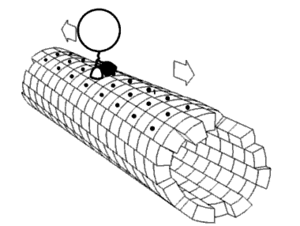
Back مركب بروتيني Arabic জটিল প্রোটিন-সমবায় Bengali/Bangla Proteinski kompleks BS Complex proteic Catalan Proteinový komplex Czech Proteinkomplex German Complejo proteico Spanish Complexo proteico Galician タンパク質複合体 Japanese 단백질 복합체 Korean

A protein complex or multiprotein complex is a group of two or more associated polypeptide chains. Protein complexes are distinct from multidomain enzymes, in which multiple catalytic domains are found in a single polypeptide chain.[1]
Protein complexes are a form of quaternary structure. Proteins in a protein complex are linked by non-covalent protein–protein interactions. These complexes are a cornerstone of many (if not most) biological processes. The cell is seen to be composed of modular supramolecular complexes, each of which performs an independent, discrete biological function.[2]
Through proximity, the speed and selectivity of binding interactions between enzymatic complex and substrates can be vastly improved, leading to higher cellular efficiency. Many of the techniques used to enter cells and isolate proteins are inherently disruptive to such large complexes, complicating the task of determining the components of a complex.
Examples of protein complexes include the proteasome for molecular degradation and most RNA polymerases. In stable complexes, large hydrophobic interfaces between proteins typically bury surface areas larger than 2500 square Ås.[3]
- ^ Price NC, Stevens L (1999). Fundamentals of Enzymology: The Cell and Molecular Biology of Catalytic Proteins (3rd ed.). Oxford: Oxford University Press. ISBN 0-19-850229-X.
- ^ Hartwell LH, Hopfield JJ, Leibler S, Murray AW (December 1999). "From molecular to modular cell biology". Nature. 402 (6761 Suppl): C47–52. doi:10.1038/35011540. PMID 10591225.
- ^ Pereira-Leal JB, Levy ED, Teichmann SA (March 2006). "The origins and evolution of functional modules: lessons from protein complexes". Philos. Trans. R. Soc. Lond. B Biol. Sci. 361 (1467): 507–17. doi:10.1098/rstb.2005.1807. PMC 1609335. PMID 16524839.